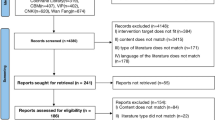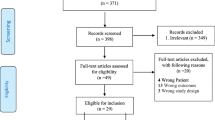Abstract
Introduction and hypothesis
Urinary incontinence (UI) is common during pregnancy and in the postpartum period. Some women appear to recover their usual urinary function but in others UI persists, playing an important role in women’s quality of life. Even though postpartum UI seems to have a multifactorial etiology, pregnancy, vaginal delivery, birth weight and parity are recognized as risk factors. This systematic review aims to evaluate the effect of one particular potential risk factor, epidural analgesia, on the development of postpartum UI in women with vaginal delivery.
Methods
PubMed, Cochrane and Scopus were searched for “epidural analgesia,” “epidural anesthesia” or “epidural” and “urinary incontinence.” All studies published until 31 July 2020 were considered. A total of 393 studies were identified, and 23 studies were included in the systematic review.
Results
From the total 23 articles included in this review, 21 showed a non-significant association between epidural analgesia and postpartum UI. One study found that the risk of postpartum SUI and any type of UI was significantly, but only slightly, increased in women with epidural analgesia. Another study showed a protective effect but was lacking control for important confounders.
Conclusion
There appears to be no association between epidural analgesia and postpartum UI. Therefore, pregnant women should not fear epidural analgesia because of a possible increased risk of UI.

Similar content being viewed by others

Abbreviations
- UI:
-
Urinary incontinence
- SUI:
-
Stress urinary incontinence
- UUI:
-
Urge urinary incontinence
References
Coulm B, Bonnet C, Blondel B. French National Perinatal Survey 2016. Paris: INSERM; 2017.
Devlieger R, Martens E, Goemaes R, Cammu H. Perinatale Activiteiten in Vlaanderen 2017. Brussel: SPE; 2018.
Bláha J, Štourač P, Grochová M, Klozová R, Richterová S, Nosková P, et al. Labor analgesia in Czech Republic and Slovakia: a 2015 national survey. Int J Obstet Anesth. 2018;35:42–51. https://doi.org/10.1016/j.ijoa.2018.04.001.
Loureiro R, Bernardes J, Ferreira M, Freitas P. Nascer em Portugal: estudo nacional descritivo. Arquivos de Medicina. 2014;28:167–71.
Bucklin BA, Hawkins JL, Anderson JR, Ullrich FA. Obstetric anesthesia workforce survey: twenty-year update. Anesthesiology. 2005;103(3):645–53. https://doi.org/10.1097/00000542-200509000-00030.
Anim-Somuah M, Smyth RM, Cyna AM, Cuthbert A. Epidural versus non-epidural or no analgesia for pain management in labour. Cochrane Database Syst Rev. 2018;5(5):Cd000331. https://doi.org/10.1002/14651858.CD000331.pub4.
Siahkal SF, Iravani M, Mohaghegh Z, Sharifipour F, Zahedian M. Maternal, obstetrical and neonatal risk factors' impact on female urinary incontinence: a systematic review. Int Urogynecol J. 2020;31(11):2205–24. https://doi.org/10.1007/s00192-020-04442-x.
Leighton BL, Halpern SH. The effects of epidural analgesia on labor, maternal, and neonatal outcomes: a systematic review. Am J Obstet Gynecol. 2002;186(5 Suppl Nature):S69–77. https://doi.org/10.1067/mob.2002.121813.
Deffieux X. Urinary incontinence and pregnancy. J Gynecol Obstet Biol Reprod (Paris). 2009;38(8 Suppl):S212–31. https://doi.org/10.1016/s0368-2315(09)73580-x.
Anim-Somuah M, Smyth RM, Jones L (2011) Epidural versus non-epidural or no analgesia in labour. Cochrane Database Syst Rev (12):Cd000331. https://doi.org/10.1002/14651858.CD000331.pub3.
Allen RE, Hosker GL, Smith AR, Warrell DW. Pelvic floor damage and childbirth: a neurophysiological study. Br J Obstet Gynaecol. 1990;97(9):770–9. https://doi.org/10.1111/j.1471-0528.1990.tb02570.x.
Strohbehn K. Normal pelvic floor anatomy. Obstet Gynecol Clin N Am. 1998;25(4):683–705. https://doi.org/10.1016/s0889-8545(05)70037-1.
Liang CC, Wong SY, Chang YL, Tsay PK, Chang SD, Lo LM. Does intrapartum epidural analgesia affect nulliparous labor and postpartum urinary incontinence? Chang Gung Med J. 2007;30(2):161–7.
Walker MP, Farine D, Rolbin SH, Ritchie JW. Epidural anesthesia, episiotomy, and obstetric laceration. Obstet Gynecol. 1991;77(5):668–71.
Schuessler B, Hesse U, Dimpfl T, Anthuber C. Epidural anaesthesia and avoidance of postpartum stress urinary incontinence. Lancet. 1988;1(8588):762. https://doi.org/10.1016/s0140-6736(88)91561-9.
Thom DH, Rortveit G. Prevalence of postpartum urinary incontinence: a systematic review. Acta Obstet Gynecol Scand. 2010;89(12):1511–22. https://doi.org/10.3109/00016349.2010.526188.
Viktrup L. The risk of lower urinary tract symptoms five years after the first delivery. Neurourol Urodyn. 2002;21(1):2–29. https://doi.org/10.1002/nau.2198.
Tähtinen RM, Cartwright R, Tsui JF, Aaltonen RL, Aoki Y, Cárdenas JL, et al. Long-term impact of mode of delivery on stress urinary incontinence and urgency urinary incontinence: a systematic review and meta-analysis. Eur Urol. 2016;70(1):148–58. https://doi.org/10.1016/j.eururo.2016.01.037.
Rortveit G, Hannestad YS, Daltveit AK, Hunskaar S. Age- and type-dependent effects of parity on urinary incontinence: the Norwegian EPINCONT study. Obstet Gynecol. 2001;98(6):1004–10. https://doi.org/10.1016/s0029-7844(01)01566-6.
Wesnes SL, Seim E. Birthweight and urinary incontinence after childbirth: a systematic review and meta-analysis. Eur J Obstet Gynecol Reprod Biol X. 2020;8:100115. https://doi.org/10.1016/j.eurox.2020.100115.
Haylen BT, de Ridder D, Freeman RM, Swift SE, Berghmans B, Lee J, Monga A, Petri E, Rizk DE, Sand PK, Schaer GN (2010)An International Urogynecological Association (IUGA)/International Continence Society (ICS) joint report on the terminology for female pelvic floor dysfunction. Int Urogynecol J 21. https://doi.org/10.1007/s00192-009-0976-9.
Gropper MA, Miller RD (2020) Miller's Anesthesia, 9th Edition. Philadelphia.
Rortveit G, Daltveit AK, Hannestad YS, Hunskaar S. Vaginal delivery parameters and urinary incontinence: the Norwegian EPINCONT study. Am J Obstet Gynecol. 2003;189(5):1268–74. https://doi.org/10.1067/s0002-9378(03)00588-x.
Dimpfl T, Hesse U, Schüssler B. Incidence and cause of postpartum urinary stress incontinence. Eur J Obstet Gynecol Reprod Biol. 1992;43(1):29–33. https://doi.org/10.1016/0028-2243(92)90239-u.
Wang Q, Yu X, Sun X, Wang J. Does epidural anesthesia influence pelvic floor muscle endurance and strength and the prevalence of urinary incontinence 6 weeks postpartum? Int Urogynecol J. 2020;31(3):577–82. https://doi.org/10.1007/s00192-019-04176-5.
Sartore A, Pregazzi R, Bortoli P, Grimaldi E, Ricci G, Guaschino S. Effects of epidural analgesia during labor on pelvic floor function after vaginal delivery. Acta Obstet Gynecol Scand. 2003;82(2):143–6. https://doi.org/10.1034/j.1600-0412.2003.00057.x.
Meyer S, Achtari C, Hohlfeld P, De Grandi P, Buchser E. Effects of epidural analgesia on pelvic floor function after spontaneous delivery: a longitudinal retrospective study. Int Urogynecol J Pelvic Floor Dysfunct. 2002;13(6):359–64; discussion 364-355. https://doi.org/10.1007/s001920200080.
Viktrup L, Lose G. Epidural anesthesia during labor and stress incontinence after delivery. Obstet Gynecol. 1993;82(6):984–6.
Burgio MA, Laganà AS, Chillè G, Sicilia A, Magno C, Butticè S, et al. Does epidural analgesia play a role in postpartum urinary incontinence? Medium-term results from a case-control study. J Matern Fetal Neonatal Med. 2016;29(11):1773–6. https://doi.org/10.3109/14767058.2015.1062870.
Serati M, Di Dedda MC, Bogani G, Sorice P, Cromi A, Uccella S, et al. Position in the second stage of labour and de novo onset of post-partum urinary incontinence. Int Urogynecol J. 2016;27(2):281–6. https://doi.org/10.1007/s00192-015-2829-z.
Brown SJ, Gartland D, Donath S, MacArthur C. Effects of prolonged second stage, method of birth, timing of caesarean section and other obstetric risk factors on postnatal urinary incontinence: an Australian nulliparous cohort study. Bjog. 2011;118(8):991–1000. https://doi.org/10.1111/j.1471-0528.2011.02928.x.
Eason E, Labrecque M, Marcoux S, Mondor M. Effects of carrying a pregnancy and of method of delivery on urinary incontinence: a prospective cohort study. BMC Pregnancy Childbirth. 2004;4(1):4. https://doi.org/10.1186/1471-2393-4-4.
Baydock SA, Flood C, Schulz JA, MacDonald D, Esau D, Jones S, et al. Prevalence and risk factors for urinary and fecal incontinence four months after vaginal delivery. J Obstet Gynaecol Can. 2009;31(1):36–41. https://doi.org/10.1016/s1701-2163(16)34051-8.
Ewings P, Spencer S, Marsh H, O'Sullivan M. Obstetric risk factors for urinary incontinence and preventative pelvic floor exercises: cohort study and nested randomized controlled trial. J Obstet Gynaecol. 2005;25(6):558–64. https://doi.org/10.1080/01443610500231435.
Hatem M, Pasquier JC, Fraser W, Lepire E. Factors associated with postpartum urinary/anal incontinence in primiparous women in Quebec. J Obstet Gynaecol Can. 2007;29(3):232–9. https://doi.org/10.1016/s1701-2163(16)32402-1.
Serati M, Salvatore S, Khullar V, Uccella S, Bertelli E, Ghezzi F, et al. Prospective study to assess risk factors for pelvic floor dysfunction after delivery. Acta Obstet Gynecol Scand. 2008;87(3):313–8. https://doi.org/10.1080/00016340801899008.
Wesnes SL, Hannestad Y, Rortveit G. Delivery parameters, neonatal parameters and incidence of urinary incontinence six months postpartum: a cohort study. Acta Obstet Gynecol Scand. 2017;96(10):1214–22. https://doi.org/10.1111/aogs.13183.
Casey BM, Schaffer JI, Bloom SL, Heartwell SF, McIntire DD, Leveno KJ. Obstetric antecedents for postpartum pelvic floor dysfunction. Am J Obstet Gynecol. 2005;192(5):1655–62. https://doi.org/10.1016/j.ajog.2004.11.031.
Diez-Itza I, Arrue M, Ibañez L, Murgiondo A, Paredes J, Sarasqueta C. Factors involved in stress urinary incontinence 1 year after first delivery. Int Urogynecol J. 2010;21(4):439–45. https://doi.org/10.1007/s00192-009-1055-y.
Johannessen HH, Stafne SN, Falk RS, Stordahl A, Wibe A, Mørkved S. Prevalence and predictors of double incontinence 1 year after first delivery. Int Urogynecol J. 2018;29(10):1529–35. https://doi.org/10.1007/s00192-018-3577-7.
Mannion CA, Vinturache AE, McDonald SW, Tough SC. The influence of Back pain and urinary incontinence on daily tasks of mothers at 12 months postpartum. PLoS One. 2015;10(6):e0129615. https://doi.org/10.1371/journal.pone.0129615.
Fritel X, Khoshnood B, Fauconnier A. Specific obstetrical risk factors for urinary versus anal incontinence 4 years after first delivery. Prog Urol. 2013;23(11):911–6. https://doi.org/10.1016/j.purol.2013.06.009.
Williams A, Herron-Marx S, Knibb R. The prevalence of enduring postnatal perineal morbidity and its relationship to type of birth and birth risk factors. J Clin Nurs. 2007;16(3):549–61. https://doi.org/10.1111/j.1365-2702.2006.01593.x.
Pizzol D, Demurtas J, Celotto S, Maggi S, Smith L, Angiolelli G, et al. Urinary incontinence and quality of life: a systematic review and meta-analysis. Aging Clin Exp Res. 2020. https://doi.org/10.1007/s40520-020-01712-y.
Yip SK, Sahota D, Chang A, Chung T. Effect of one interval vaginal delivery on the prevalence of stress urinary incontinence: a prospective cohort study. Neurourol Urodyn. 2003;22(6):558–62. https://doi.org/10.1002/nau.10113.
Glazener CM, Herbison GP, MacArthur C, Lancashire R, McGee MA, Grant AM, et al. New postnatal urinary incontinence: obstetric and other risk factors in primiparae. Bjog. 2006;113(2):208–17. https://doi.org/10.1111/j.1471-0528.2005.00840.x.
Wilson MJ, Moore PA, Shennan A, Lancashire RJ, MacArthur C. Long-term effects of epidural analgesia in labor: a randomized controlled trial comparing high dose with two mobile techniques. Birth. 2011;38(2):105–10. https://doi.org/10.1111/j.1523-536X.2010.00466.x.
Delancey JO, Kane Low L, Miller JM, Patel DA, Tumbarello JA. Graphic integration of causal factors of pelvic floor disorders: an integrated life span model. Am J Obstet Gynecol. 2008;199(6):610.e611–5. https://doi.org/10.1016/j.ajog.2008.04.001.
Regina, Ruiz de Viñaspre Hernández Encarnación, Rubio Aranda Concepción, Tomás Aznar (2013) Incontinencia urinaria a los 6 meses del parto. Medicina Clínica 141(4) 145-151.https://doi.org/10.1016/j.medcli.2012.05.020
Acknowledgements
The authors alone are responsible for the content and writing of the article.
Funding
No specific funding was obtained.
Author information
Authors and Affiliations
Contributions
MS Cardoso: Project development, Data collection, Data analysis, Manuscript writing and editing.
T Rodrigues: Project development, Data collection, Data analysis, Manuscript writing and editing.
MF Valente: Manuscript writing, Anesthesiology counseling.
Corresponding author
Ethics declarations
Conflict of interest
None.
Additional information
Publisher’s note
Springer Nature remains neutral with regard to jurisdictional claims in published maps and institutional affiliations.
Rights and permissions
About this article
Cite this article
Cardoso, M.S., Valente, M.F. & Rodrigues, T. The effect of epidural analgesia on postpartum urinary incontinence: a systematic review. Int Urogynecol J 33, 1421–1434 (2022). https://doi.org/10.1007/s00192-021-04988-4
Received:
Accepted:
Published:
Issue Date:
DOI: https://doi.org/10.1007/s00192-021-04988-4



